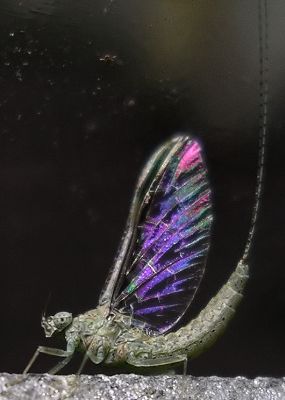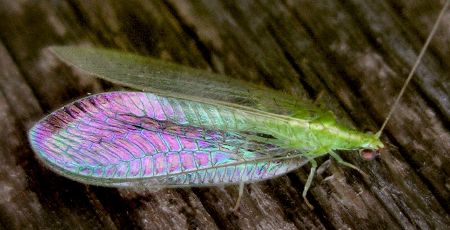
small minnow mayfly
 small minnow mayfly |
The multiple layers of chitin that form the cuticle of an insect's exoskeleton are the perfect canvas for the production of structural coloration. The effect might occur anywhere on an insect's body, but the wings, where the cuticle is stretched thin and often transparent, give the most likely chance of an exceptional display. Iridescence is a result of thin-film interference patterns: light waves are reflected off both the upper and lower surfaces and, as they interfere with each other, produce a variety of tints depending on the angle of the light, the distance between the surfaces, and the viewer's perspective.
Living insects don't often hold still, and when they are confronted by a camera lens, which probably resembles nothing less than a huge mouth about to swallow them, they are apt to attempt escape. If they have wings, flight is the response of choice. As a second resort, perhaps when it is too cold for their muscles to function or they are just tired, they usually try to retreat by crawling, turning various directions to get out of the line of sight or seeking a crevice in which to hide. All this motion means that there are multiple opportunities to glimpse the resulting hues, but generally not much time in which to appreciate them.
Flies, especially those that spend time on flowers in the sunlight, often display shimmering colors when photographed. The pastel shades on tiny wings might be lovely, but they are also quite difficult to see, given the small size of the surfaces and the bright light of the surrounding environment. The black bodies of some wasps offer
 green lacewing |
The best subjects for entomological iridescence are nocturnal species with large wings but weak flight. Moths can mostly be eliminated from consideration because of the dense scaling on their wings that effectively breaks up the smooth surfaces needed to show a whole rainbow. Antlions, lacewings, owlflies, and mayflies, though, are excellent targets. These are at times numerous, and they are attracted to lights during the night, where they may be found resting at dawn. Big enough to be noticed, but likely to remain relatively still when approached, they can be found in dimly lit areas with enough dark background to show off the ephemeral results of the changing reflected light on their gossamer wings.
Even when all the factors coalesce, iridescence is still not guaranteed. I often see just a hint of it, even while moving a hand-held light around a perfect subject. But when the colors suddenly pop out in a lustrous display, it is like discovering a hidden gem in gravel. Never expecting it, half the fun is the surprise of being confronted by this delightful optical phenomenon.